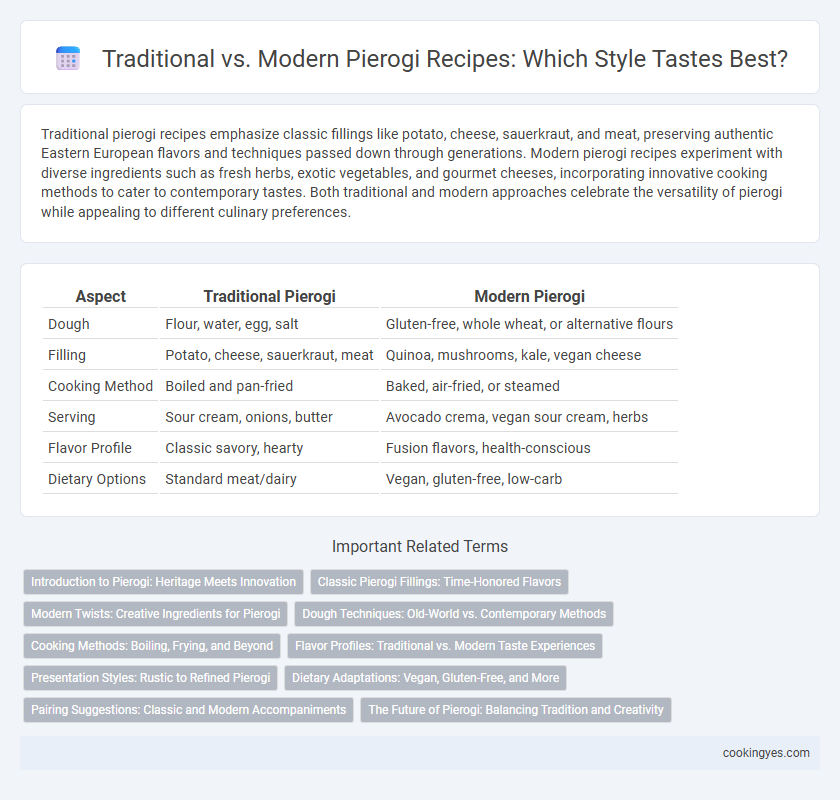Traditional pierogi recipes emphasize classic fillings like potato, cheese, sauerkraut, and meat, preserving authentic Eastern European flavors and techniques passed down through generations. Modern pierogi recipes experiment with diverse ingredients such as fresh herbs, exotic vegetables, and gourmet cheeses, incorporating innovative cooking methods to cater to contemporary tastes. Both traditional and modern approaches celebrate the versatility of pierogi while appealing to different culinary preferences.
Table of Comparison
| Aspect | Traditional Pierogi | Modern Pierogi |
|---|---|---|
| Dough | Flour, water, egg, salt | Gluten-free, whole wheat, or alternative flours |
| Filling | Potato, cheese, sauerkraut, meat | Quinoa, mushrooms, kale, vegan cheese |
| Cooking Method | Boiled and pan-fried | Baked, air-fried, or steamed |
| Serving | Sour cream, onions, butter | Avocado crema, vegan sour cream, herbs |
| Flavor Profile | Classic savory, hearty | Fusion flavors, health-conscious |
| Dietary Options | Standard meat/dairy | Vegan, gluten-free, low-carb |
Introduction to Pierogi: Heritage Meets Innovation
Pierogi recipes reflect a rich heritage dating back centuries in Eastern European cuisine, traditionally filled with potatoes, cheese, sauerkraut, or meat. Modern variations innovate by incorporating diverse ingredients like sweet fruits, spices, or vegan substitutes, appealing to contemporary palates. This fusion of time-honored techniques and creative flavors highlights pierogi's evolving role from classic comfort food to gourmet culinary art.
Classic Pierogi Fillings: Time-Honored Flavors
Classic pierogi fillings emphasize time-honored flavors such as savory potato and cheese, sauerkraut, mushroom, and sweet fruit varieties like blueberry. Traditional recipes highlight simplicity and regional authenticity, using fresh ingredients that have been cherished for generations. These enduring fillings provide a flavorful foundation that modern variations often build upon or reinvent.
Modern Twists: Creative Ingredients for Pierogi
Modern pierogi recipes incorporate inventive fillings like butternut squash with sage, goat cheese with caramelized onions, or spicy chorizo paired with smoked gouda, enhancing traditional flavors. Chefs experiment with gluten-free or whole-wheat dough to cater to dietary preferences while preserving the dough's tender texture. Fusion influences introduce ingredients such as kimchi, curry spices, or truffle oil, elevating pierogi into gourmet, globally inspired dishes.
Dough Techniques: Old-World vs. Contemporary Methods
Traditional pierogi dough relies on simple ingredients like flour, water, and eggs, kneaded to a firm yet pliable consistency and often rested to develop gluten for elasticity. Contemporary methods incorporate alternative flours such as whole wheat or gluten-free variants and may include ingredients like sour cream or yogurt to enhance tenderness and flavor. The shift from hand-kneading and resting to using food processors or stand mixers reflects a balance between preserving old-world texture and embracing modern convenience.
Cooking Methods: Boiling, Frying, and Beyond
Traditional pierogi recipes primarily rely on boiling dough pockets filled with savory or sweet ingredients, preserving authentic Eastern European flavors and textures. Modern cooking methods have expanded to frying and baking, offering a crispy exterior while maintaining the tender filling, appealing to contemporary tastes. Innovative techniques such as air frying and sous vide are increasingly popular for enhancing texture and reducing oil use without compromising flavor.
Flavor Profiles: Traditional vs. Modern Taste Experiences
Traditional pierogi recipes emphasize classic fillings such as potato and cheese, sauerkraut, or meat, delivering hearty, comforting flavors rooted in Eastern European heritage. Modern pierogi variations introduce innovative ingredients like pumpkin, goat cheese, or exotic spices, creating diverse and bold taste experiences that appeal to contemporary palates. The contrast between traditional and modern pierogi highlights a dynamic evolution in flavor profiles, balancing nostalgia with culinary experimentation.
Presentation Styles: Rustic to Refined Pierogi
Traditional pierogi recipes emphasize a rustic presentation with hand-pinched edges and a flour-dusted surface, often served on wooden boards or ceramic plates to enhance their homemade appeal. Modern pierogi presentations showcase refined plating techniques, incorporating vibrant garnishes like microgreens, edible flowers, and drizzles of infused oils or reductions for visual sophistication. Contemporary chefs experiment with innovative shapes and colorful doughs made from natural ingredients to elevate pierogi from comfort food to gourmet cuisine.
Dietary Adaptations: Vegan, Gluten-Free, and More
Traditional pierogi recipes typically feature wheat flour dough filled with ingredients like potatoes, cheese, and meat, while modern adaptations embrace dietary needs by incorporating gluten-free flours and plant-based fillings such as mushrooms, lentils, and tofu. Vegan pierogi versions replace dairy and eggs with alternatives like cashew cream and aquafaba to maintain texture and flavor without animal products. These dietary adaptations not only broaden pierogi accessibility but also enhance nutritional profiles, catering to diverse preferences and health requirements.
Pairing Suggestions: Classic and Modern Accompaniments
Traditional pierogi recipes often pair perfectly with sour cream, caramelized onions, and crispy bacon, enhancing their rich and comforting flavor profile. Modern accompaniments introduce creative elements like truffle oil, balsamic glaze, or microgreens, adding a sophisticated twist to the classic dish. Exploring both classic and contemporary pairings elevates the pierogi experience, catering to diverse palates and culinary trends.
The Future of Pierogi: Balancing Tradition and Creativity
Traditional pierogi recipes emphasize classic fillings such as potato, cheese, sauerkraut, and meat, preserving Eastern European culinary heritage through time-tested techniques. Modern pierogi innovations incorporate diverse ingredients like spinach, mushrooms, seafood, and global spices, reflecting contemporary tastes and creative cooking trends. The future of pierogi lies in balancing these authentic flavors with inventive variations, enhancing cultural identity while appealing to evolving culinary preferences worldwide.
Traditional vs Modern for Pierogi Recipes Infographic

 cookingyes.com
cookingyes.com